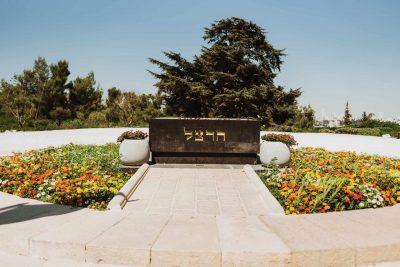
by: Janet Aslin, BFP Staff Writer
 Situated next to the Jerusalem Forest on the western side of the city stands a hill—Har (Mount) Herzl, the site of Israel’s national cemetery, where the bodies of fallen soldiers and prime ministers are buried. It is a peaceful oasis within a vibrant and bustling city; a place where one can come and reflect on Israel’s journey since the modern state was reborn in 1948.
Situated next to the Jerusalem Forest on the western side of the city stands a hill—Har (Mount) Herzl, the site of Israel’s national cemetery, where the bodies of fallen soldiers and prime ministers are buried. It is a peaceful oasis within a vibrant and bustling city; a place where one can come and reflect on Israel’s journey since the modern state was reborn in 1948.
Mount Herzl is actually a complex of gardens, cemeteries and memorials which honor the memories of those who fell in defense of the State of Israel, as well as her prominent leaders. Jews whose lives were snuffed out by Nazi brutality and Ethiopian Jews who died on their way to the Promised Land—just to name two groups of people who didn’t actually set foot in Israel—are also remembered and honored here on the hill in Jerusalem known as Mount Herzl, or the Mount of Remembrance.
Second Choice
The current site was not the first choice for Israel’s national memorial to her fallen soldiers and leaders. In 1934, Zionist leader Menachem Ussishkin envisioned the Nicanor Cave, an ancient Jewish burial site on Mount Scopus, as the perfect place. However, during Israel’s War of Independence, that area was cut off from Jewish-held western Jerusalem, and a new location had to be found.
There was a certain sense of urgency in finding the site. Theodor Herzl, known as the “spiritual father of the Jewish state,” had written in his will: “I wish to be buried in a metal coffin next to my father, and to remain there until the Jewish people will transfer my remains to Eretz Israel [Land of Israel].” When he died in 1904 at the age of 44, he was buried in Vienna until his remains were brought to Israel in 1949. He was reburied on August 17, 1949, on top of the hill that was renamed in his honor.
Today, as you step through the gate at Mount Herzl’s imposing entrance with its wall of Jerusalem stone, your eye will be drawn to a large sculpted hedge on the hillside with a menorah (seven-branched candelabra) and the words הר הרצל (Har Herzl). Winding pathways lead up the hill to the Nations Garden, where visiting heads of state planted trees in the early 1960s. You can stop and rest on one of the many benches or look out over the city of Jerusalem from one of the two observation areas.
Leaving the Nations Garden, we come to Mount Herzl’s focal point—a black marble tombstone with four Hebrew letters which spell the name “Herzl.” From this prominent spot on the crest of the hill, you can see the Judean Hills on one side and the city of Jerusalem—both old and new—on the other. A large plaza faces the tombstone where each year the State of Israel officially marks the end of Yom HaZikaron (Memorial Day) and then immediately transitions to Yom HaAtzmaut (Independence Day). The very first Independence Day celebration was held here in 1950.
Israel’s military cemeteries are located on the northern slope of Mount Herzl. The first soldiers buried here in 1949 were Jerusalem residents who fell in the War of Independence. Sadly, as the Jewish state grew, so did the number of graves. Today the military portion of the site consists of a number of small, almost intimate sections arranged according to the war or conflict during which the soldiers were killed.
The gravestones are plain and record the soldier’s name, birthplace and age at time of death, as well as a few other pieces of information. Officers and enlisted men are buried next to each other. It is a sobering experience to wander among them, taking note of the fact that so many young lives were cut short in Israel’s many defensive wars.
More than a Cemetery
Mount Herzl is so much more than a national military cemetery—it is a tribute to the establishment of the nation of Israel. The Herzl Museum, run by the World Zionist Organization, is definitely worth visiting. Its 4D exhibits allow the visitor to experience Herzl’s journey from an Austrian journalist to the Zionist visionary who gave his heart’s blood for the establishment of a permanent home for the Jewish people in the land of their forefathers.
Sometimes I walk the connecting path, constructed by Israeli youth, leading from Mount Herzl to Yad Vashem, Israel’s Holocaust memorial. Along the way are commemorative markers, telling of the Jewish journey from the ovens of Auschwitz to the founding of the State of Israel. As I read them, I am reminded of the faithfulness of God. The prophet Jeremiah wrote of this day, saying, “Behold, I will gather them out of all countries where I have driven them…I will bring them back to this place, and I will cause them to dwell safely.” (Jer. 32:37). And here on Mount Herzl, we remember.
Photo Credit: Click photo to see photo credit
All logos and trademarks in this site are property of their respective owner. All other materials are property of Bridges for Peace. Copyright © 2025.
Website Site Design by J-Town Internet Services Ltd. - Based in Jerusalem and Serving the World.